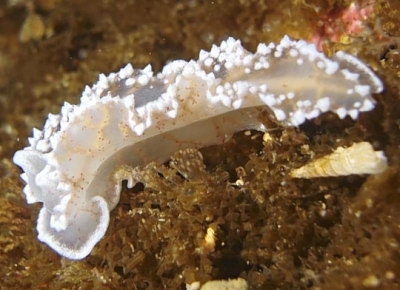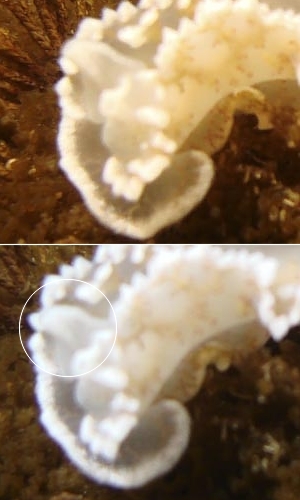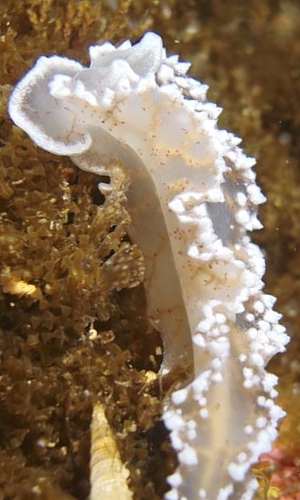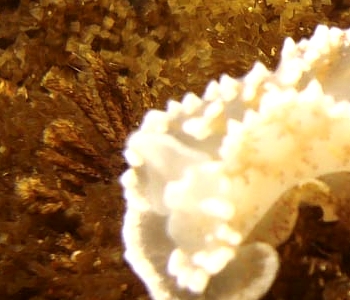Pseudotritonia quadrangularis from Antarctica
February 22, 2007
From: David Cothran

Hi Bill,
Thanks very much for your reply [message #19508 ]. I am working in the Antarctic at the moment, on the National Geographic Endeavour. I’m afraid that I don’t have any other good images of the putative Pseudotritonia quadrangularis, but here are two poor images that show the rhinophores a bit better. I have the impression that this is quite a rare species around the Antarctic Peninsula, but this might be due to it’s superficial similarity to Charcotia granularis. I dove at Cuverville Island again today, and kept an eye out for Pseudotritoniabut didn’t see any this time. I’ll keep my eyes peeled during the next few days as we wrap up our Antarctic season.
Locality: Cuverville Island, Antarctic Peninsula, Southern Ocean. 18 meters. 30 mm. 8 February 2007. Rock wall. Photo: David Cothran
Thanks again for your help.
David
david@wandering-eye.com



Dear David,
The extra two photos of the head are excellent as they show the extended shape of the rhinophores quite well. As I mentioned before, these Antarctic animals are difficult to identify just from photos because most of them have been defined by their internal anatomy. That is not to say that when we know them better we will not find good external characters to use for field identifications. Species of the arminoid family Charcotiidae [Charcotia, Pseudotritonia] are quite similar externally. The notum (or mantle) is wider than the foot, and along each side it has a number of waves or folds. There is an oral veil, and the anus opens about halfway back on the right side of the body. There is some doubt about the shape of the rhinophores which are variously described as 'petal-shaped' and 'digitiform'. In this species the rhinophores appear to be cone-shaped with at least three radiating ridges. It appears from the two new photos that these rhinophores can stretch out into a digitiform [finger-like] tip.
I won't go into the internal anatomical differences except for the few we can see through the body wall. In Charcotia, the digestive gland has some branches which extend out to the dorsal surface of the mantle, and rarely to the edge of the mantle. There are small tubercles along the mantle edge and scattered all over the dorsum.
In Pseudotritonia the digestive gland has branches which as well as extending out to the dorsal surface of the mantle and the mantle edge, also reach the sides of the body and the foot. Two species, Pseudotritonia quadrangularis and P. antarctica, are reported to have some papillae at the mantle edge, but these apparently disappear in preserved specimens. Of these two species, P. quadrangularis is reported to have 'petal-shaped' rhinophores, while the other is said to digitiform rhinophores.
On those grounds, which I admit are a bit flimsy, I would identify your animal as Pseudotritonia quadrangularis. One other interesting observation is that the animal seems to be on a large bryozoan colony. As far as I know there is no information on feeding in any species of Pseudotritonia, or any charcotiid for that matter, but Wagele et al (1995) report a specimen of Pseudotritonia gracilidens Odhner, 1944 on the bryozoan Arachnopusia inchoata. It may be just a coincidence, as the mouth parts suggest a cnidarian prey, but it is worth keeping it in mind for future finds.
Best wishes,
Bill Rudman
Related messages
-
Another Pseudotritonia quadrangularis
From: Nerida Wilson, February 23, 2007
